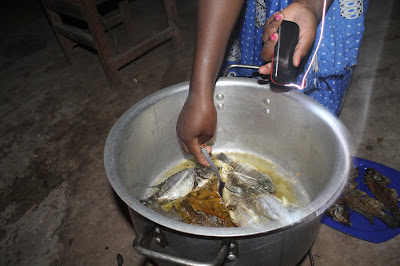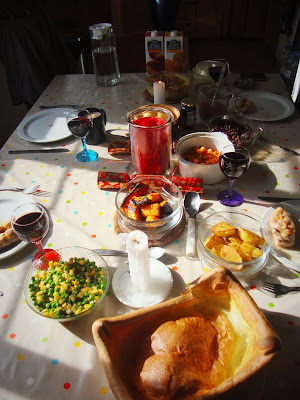Quite
a few people have asked me what the food is like in Zambia so I thought this
would be a good topic for a blog post. As many of you know, I love food - especially
anything sweet! So here’s a taster of some of the food-related experiences,
disappointments and cultural differences that I have encountered during my time
here.
 |
| Sweet tooth |
New experiences
The
most interesting food I have tried since coming to Zambia has to be
caterpillars. I ate them for the first time when I was on holiday in Livingstone
with my family a few weeks ago. I had often seen them sold in the market in
Ndola but never found them particularly tempting. Caterpillars are a local
delicacy there and don't look very appealing, but when I tasted them they were
better than I had expected. I’d describe them as tasting like burned calamari. The
fact that they were so well cooked definitely aided digestion, as they were so black
it didn't look or feel like I was eating bugs!
 |
| Eating caterpillars |
One
of the popular foods that I am yet to try here is kapenta, which is a small,
smelly fish. I’ve bought it from the market for some of our Arise families and it
always makes the car smell. However I can definitely confirm that one Zambian
delicacy that I won’t be sampling is one we wouldn’t dream of eating in the
UK….tinned rat!
 | ||
Kapenta, tomatoes and onions
|
One
important food group in my life is chocolate, particularly Cadburys Dairy Milk.
I love the stuff! This meant that I was very excited to find that it is now
sold in the local supermarket here in Ndola. They actually sell a number of
flavours that aren’t sold in the UK, such as biscuit, mint, and coconut &
cashew nut. However, I was disappointed to discover that due to the hot weather,
a different type of milk is used in making the chocolate so it definitely
doesn’t taste as good as the Cadburys we have at home. I’ve been extremely
grateful to all the friends and family who have brought or sent out chocolate
for me from the UK…it is very much appreciated, even if it doesn’t last very
long!
 |
| An excellent stash of 'real' Cadburys that my church sent me last year |
Local traditions
The
most traditional Zambian meal is nshima (maize), which is the country’s staple
food. Most people here eat it regularly and some families have it for almost every
meal. I have found it similar to ugali in Kenya, and sadzma in Zimbabwe, so I
guess that it is a popular food in most African countries which each have their
own name for it. Nshima is usually eaten with 'soup' which is a sauce,
and some kind of protein if you can afford to buy it, e.g. a boiled egg,
chicken, kapenta or a whole fish (including the eyes!).
 |
| Nshima, fish, veg and soup |
 |
| The children at school love nshima |
Another
meal that seems to be eaten often here is rice and beans, although this isn’t a
traditional Zambian dish. There are several different types of beans available
here - my favourites are red beans, which are surprisingly tasty for a veggie
dish! We often use the leftover beans to make some rather tasty bean burgers.
Many
local people cook on a brazier (a metal container that holds hot coals) which is also
how the children's porridge is cooked at school in the morning. It means that
Zambians get through a lot of charcoal but one good point is that this method
doesn’t rely on having power - very important here considering the frequent
load shedding.
 |
| My favourite use of a brazier - cooking marshmallows |
Oil overload
I
have noticed that Zambians tend to use a huge amount of oil, salt and sugar in
their cooking. I don't mind the sugar because I have such a sweet tooth, but I
don’t enjoy the large amount of oil that is put into our meals! A friend of
mine told me that she went camping in the bush with a group of 10 people and bought five
litres of oil for the three week trip. She couldn’t quite believe that it was used
up in just two days! It’s little wonder that it seems quite common for people here
to suffer with high blood pressure.
 |
| Zambians love oil (which ironically they call 'salad'!) |
Foodie differences
We
cook for ourselves at weekends and during holidays, and so I have found that
the biggest difference in cooking here is that you can't get all of the ingredients
that you can at home, and the selection available seems to vary with each trip
to the supermarket. For example, it took three different shopping trips before
we could find cream in the supermarket. I do miss having a Co-op around the
corner and a Tesco Express down the road like I do at home, but it’s just an
inconvenience rather than a real problem, in the grand scheme of things.
 |
| Occasionally we cook a roast dinner for a taste of home |
Food
is quite expensive here and many people that we support in the local villages
struggle to even eat every day, so I feel very fortunate to be able to afford to
eat three good meals a day. Living in Zambia has not changed my love for food,
but it has certainly made me more grateful for it.

No comments:
Post a Comment